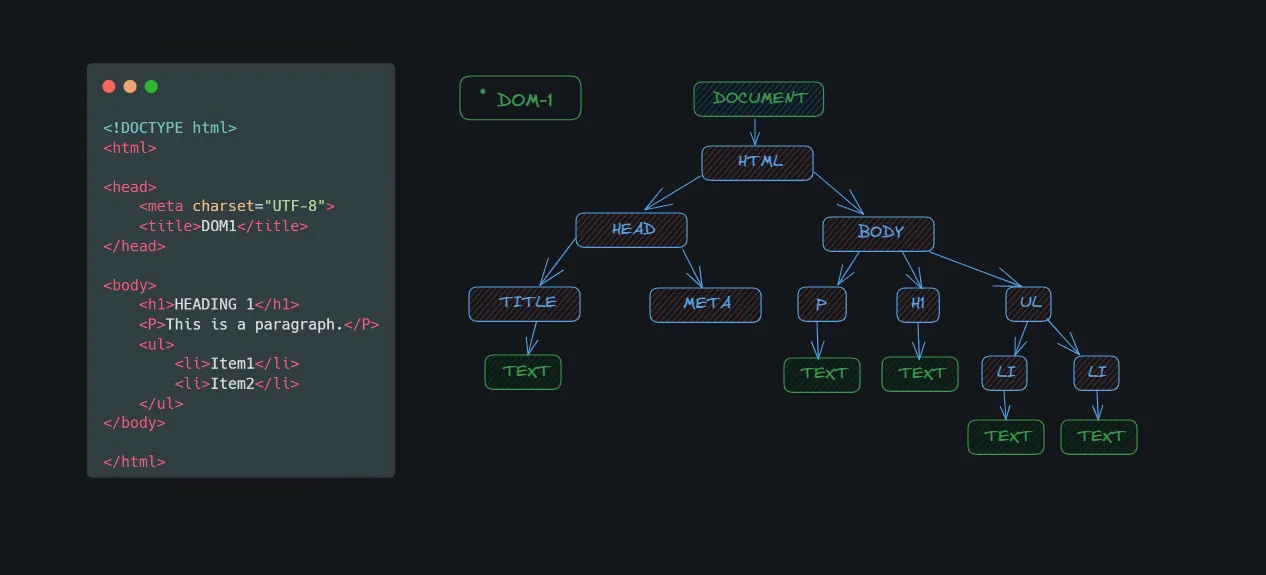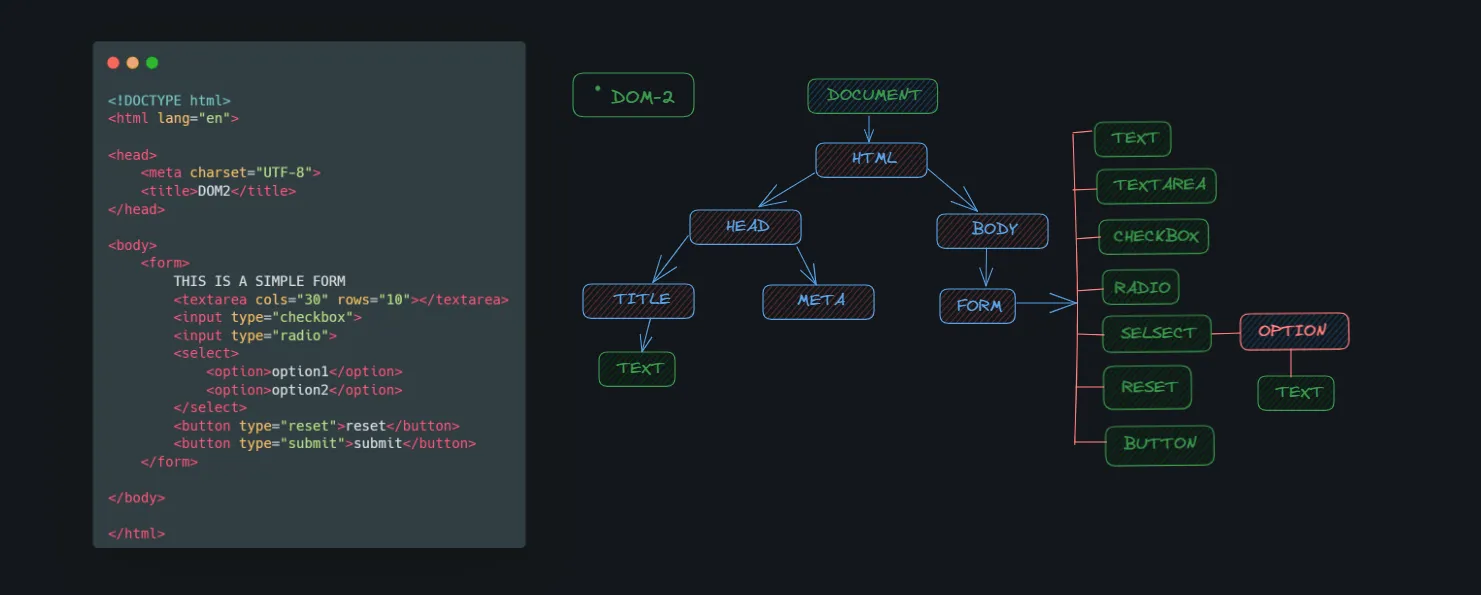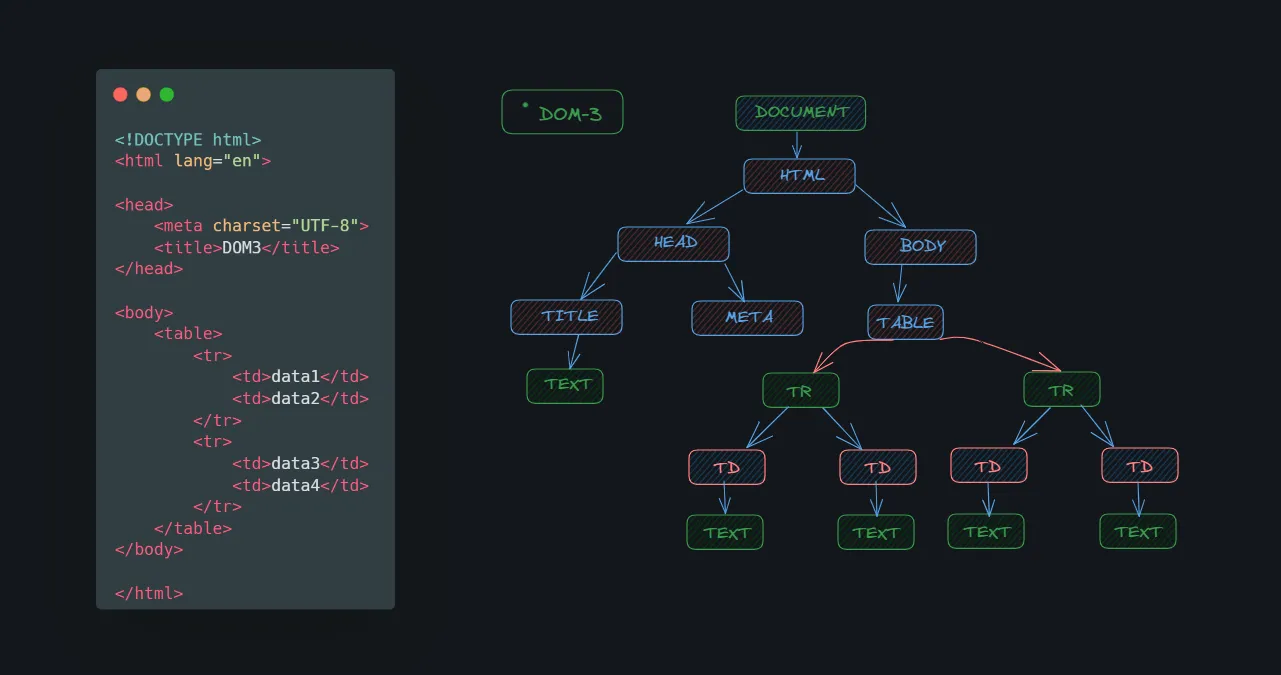Understanding DOM Structure: A Visual Guide
The Document Object Model (DOM) is a programming interface for HTML documents. It represents the page as a tree-like structure where each HTML element becomes a node in the tree. Let’s explore three different DOM structures with visual examples.
Basic Document Structure (DOM1)
Let’s start with a basic HTML document structure:
<!doctype html><html> <head> <meta charset="UTF-8" /> <title>DOM1</title> </head> <body> <h1>HEADING 1</h1> <p>This is a paragraph.</p> <ul> <li>Item1</li> <li>Item2</li> </ul> </body></html>
Here’s how this code creates a DOM tree:
In this structure:
- The document root contains the HTML element
- HTML branches into HEAD and BODY
- HEAD contains META and TITLE elements
- BODY contains H1, P, and UL elements
- UL contains two LI elements
Form Structure (DOM2)
Next, let’s look at how forms are structured in the DOM:
<!doctype html><!doctype html><html lang="en"> <head> <meta charset="UTF-8" /> <title>DOM2</title> </head> <body> <form> THIS IS A SIMPLE FORM <textarea cols="30" rows="10"></textarea> <input type="checkbox" /> <input type="radio" /> <select> <option>option1</option> <option>option2</option> </select> <button type="reset">reset</button> <button type="submit">submit</button> </form> </body></html>
Here’s the DOM tree for this form structure:
Key points about form structure:
- The FORM element contains multiple form controls
- Each form control (INPUT, TEXTAREA, SELECT) is a direct child of the form
- SELECT elements contain OPTION elements as children
- Buttons are siblings to other form controls
Table Structure (DOM3)
Finally, let’s examine how tables are represented in the DOM:
<!doctype html><!doctype html><html lang="en"> <head> <meta charset="UTF-8" /> <title>DOM3</title> </head> <body> <table> <tr> <td>data1</td> <td>data2</td> </tr> <tr> <td>data3</td> <td>data4</td> </tr> </table> </body></html>
Here’s the DOM tree for this table structure:
Key points about table structure:
- TABLE element is the parent container
- TR (table row) elements are direct children of TABLE
- TD (table data) elements are children of TR elements
- Each level creates a new branch in the tree
Understanding DOM Relationships
In all these examples, we can observe several important DOM relationships:
1. Parent-Child Relationships
- HTML is the parent of HEAD and BODY
- UL is the parent of LI elements
- TR is the parent of TD elements
2. Sibling Relationships
- HEAD and BODY are siblings
- Multiple LI elements are siblings
- Multiple TD elements within a TR are siblings
3. Nesting Levels
- Each indentation in the HTML represents a new level in the DOM tree
- Elements can be nested multiple levels deep
- Each nesting creates a new branch in the tree
Why DOM Structure Matters
1. Understanding DOM structure is crucial for web development
- Writing efficient JavaScript that manipulates web pages
- Styling elements with CSS
- Debugging layout and content issues
- Creating accessible web content
2. The DOM tree structure helps developers understand
- Navigate between elements programmatically
- Modify content and structure dynamically
- Apply styles and behaviors to specific elements
- Understand how browsers interpret HTML documents
Conclusion
The Document Object Model provides a structured way to represent HTML documents. By understanding how different HTML elements create DOM nodes and how these nodes relate to each other, you can better manipulate web pages using JavaScript and create more maintainable code.
Remember that the DOM is:
- A tree-like structure
- Created automatically by the browser
- Dynamic and can be modified
- The foundation for web page interactivity
Practice exploring DOM structures using browser developer tools to better understand how your HTML creates DOM trees and how elements relate to each other.
Happy Learning!
